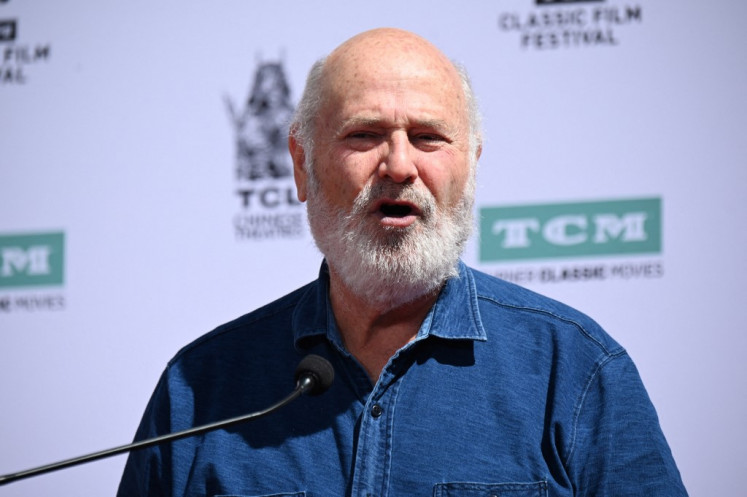Popular Reads
Top Results
Can't find what you're looking for?
View all search resultsPopular Reads
Top Results
Can't find what you're looking for?
View all search resultsUnfolding Anfield
Young artist Anfield Wibowo showcases his works in an exhibition at Balai Budaya Jakarta.
Change text size
Gift Premium Articles
to Anyone
T
he great movie director Federico Fellini once said: “All art is autobiographical. The pearl is the oyster’s autobiography”. The pearl is created out of discomfort and pain, and art is the artist’s effort to ease the pain that was inflicted from either inside or outside our body.
And that is why most great artists are by nature emotionally fragile, whether it is through depression, mental disorders or a damaged upbringing (a broken home, for instance).
Art serves as a catharsis (from the Greek word catharsis, meaning “purification” or “cleansing”) originally used by Aristotle in his writing Poeticsthrough the purgation of emotions that results in renewal, balance and restoration.
Such a notion is seen in a painting exhibition showcasing the works of Anfield Wibowo at Balai Budaya Jakarta until Sunday.
Born in 2004, this young artist has produced paintings with a clear influence of expressionism but has already established a strong artistic identity. The high value of his art speaks for itself, born out of his strong desire to express, not to impress.
In fact, he has a lot of aspects to impress: more than 300 paintings at just 14 years of age, having already his 4th solo exhibition and being born deaf and diagnosed with Asperger syndrome when he was 10.
Forty-one paintings are exhibited this week, and another young Aspie (the term for us who have Asperger’s), Arkan Tanriwa, made a poignant poem from the painting The Big City at Night and read it at the opening night after an engaging speech by Budi Kaliwono, president director of city bus operator Transjakarta.
Arkan is a student of the University of Indonesia’s School of Literature, while Anfield studies at the Pangudi Luhur School for Special Needs.
“Since he was around 3 years old, he preferred stationery to toys in general, and he continuously made sketches. He also fancied jigsaw puzzles and toy building blocks. By drawing and scribbling, Anfield trained his quite clumsy soft motoric skills. He is always highly focused in doing it, and it was very clear that he enjoys it, even now that he does ‘real’ paintings,” explained Donny Mardonius, Anfield’s father.
At the age of 6, Anfield started to use crayons and colored pencils, and at 7 he began to paint on canvas with acrylic paint, which he pursues until now. “Anfield is our only child, and he is an autodidact in painting, although he did attend a painting course for a short time. To paint a complete work, he requires a maximum of two hours; after that, it will never be touched again,” Donny further explained.
Nowhere in the exhibition is it stated that the artist is a person with “special needs”. This is ideally how we should value artistic creations — they are, and should be, based on their artistic merits, not on the age, special traits, eccentricity or disabilities of the artist.
Anfield has proven that his artistic products can be independent from the artist who created them. Beethoven’s music made a huge impact not because (or even in spite) of his deafness, and Van Gogh’s paintings are powerful and influential without anybody having to know about his psychotic episodes and delusions, or that he cut off part of his ear.
Anfield strikes as a typical young Aspie — he does what he feels like, without being filtered, and he shows little interest in interacting with people (which is more due to his deafness as well), although he does through his mobile phone.
“Many of Anfield’s works, this time, will be donated to the Istana KSJ charity foundation. So far, 10 to 15 of Anfield’s works have been auctioned for this purpose to other foundations,” Donny said.
Asperger syndrome (AS) belongs to the Autism spectrum, discovered by Dr. Hans Asperger, whose papers were published in 1944. Most Aspies are equally, or even more intelligent, than non-Aspies and tend to be obsessive or like to do the same thing repetitively and regularly.
Each Aspie is different, depending on which part of the brain is affected. We mostly excel in a certain thing but are clumsy in social skills and “normal” things in life, such as interpreting three-dimensional figures on a flat surface and driving.
Some prominent people with AS include the actor Sir Anthony Hopkins and actress Daryl Hannah, Pokemon founder Satoshi Tajiri and artist Andy Warhol. It is estimated that one of 250 people bears AS, and fewer than 25 percent of Aspies are female.
One thing I would like to rectify is the common belief that people with AS can’t be empathic. That’s very wrong. In fact, after talking with fellow Aspies, I can say that we are just the opposite: We can even be hypersensitive people.
Aspies just don’t know, most of the time, how to express it physically or verbally. And I think this is where art comes in — it can express things we are unable to express through gestures, words or actions. And art offers less possibility of being misunderstood, since art is supposed to be a universal form of communication.
— The writer is a composer and pianist with Asperger syndrome and Tourette syndrome











